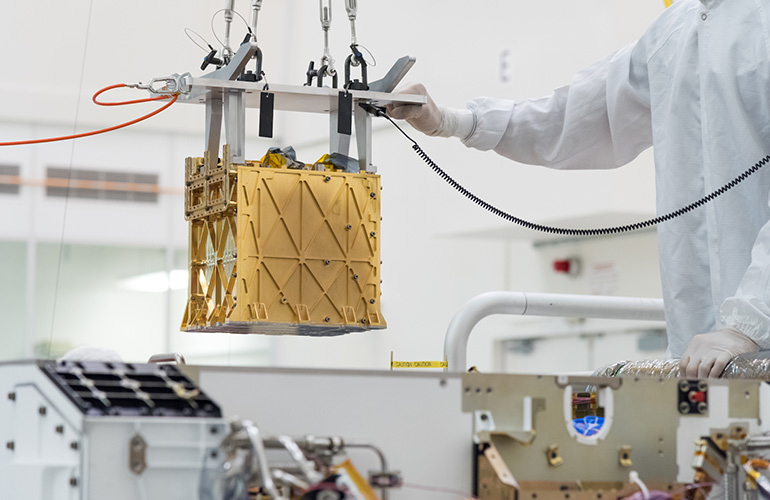|
Listen to this article  |

Technicians lowering MOXIE into the Perseverance Rover in 2019. | Source: NASA/JPL
NASA released the results of its Perseverance Rover’s first seven oxygen generation runs on Mars. The runs all took place during the rover’s first year on the red planet, from February 2021 to the end of 2021, and were performed using the robot’s Mars Oxygen In-Situ Resource Utilization Experiment (MOXIE).
Developed with the Massachusetts Institute of Technology (MIT), MOXIE’s job is to take in carbon dioxide and produce oxygen. The device is about the size of a car battery, but NASA imagines a future version of the device would be about 100 times larger.
Carbon dioxide makes up about 95% of the Martian atmosphere, giving Perseverance plenty to work with when making oxygen. During its first seven runs, MOXIE created about 6 grams of oxygen per hour. In a more recent run, MOXIE’s eleventh so far, the team was able to get that rate up to about 10.5 grams an hour, about half the amount a human would need to survive.
The team was able to achieve this higher production rate because of the conditions on Mars currently. The planet is in the middle of its winter, when cold nights and relatively high atmospheric pressures create the highest air density of the year. The more carbon dioxide in the air, the more oxygen MOXIE can produce.
MOXIE’s main purpose, however, isn’t to help humans breathe on Mars. Instead, NASA wants to use MOXIE’s technology to make enough propellant to lift a human crew of about four to six astronauts off the surface of the planet and into orbit. To do this, the device will need to make 2-3 kg of oxygen an hour.
One of MOXIE’s main limitations right now is its power supply. Creating kilograms of oxygen every hour will require around 25 kilowatts of power, and Perseverance only produces about 100 watts for MOXIE to use. Only 10% of that power goes towards creating oxygen, the rest is used to run the compressor that takes in air, electronics for the device and more.
The team’s research was published in Science Advances earlier this week.
Other Perseverance milestones
Perseverance’s main mission on Mars is to collect rock samples that will eventually be returned to Earth. The rover cored its first rock sample in September 2021, and so far it has collected 12 rock samples that will hopefully give scientists insight into whether there was ancient life on the planet.
The rover has already started scouting for good spots for the Mars Sample Return (MSR) Campaign to land. NASA plans to launch its Earth Return Orbiter in fall 2027 and its Sample Retrieval Lander in summer 2028. The lander is expected to make it to the surface of Mars in 2030. If all goes well, the samples should return to Earth in 2033.
You can interact with a 3D rendering of the Perseverance Rover by clicking and dragging to turn the rover or zooming in to look at specific parts below.
The Perseverance Rover won a 2022 RBR50 Robotics Innovation award for its achievement of coring its first rock from our sister publication Robotics Business Review.
Credit: Source link


Comments are closed.